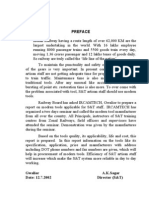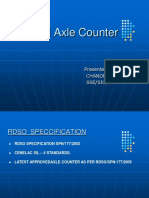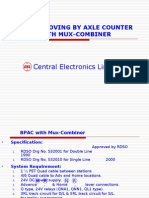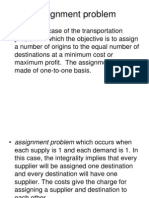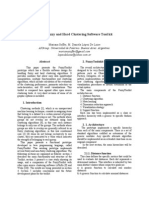Az Ls Eldyne Single Section Digital Axle Counter: Part-C
Az Ls Eldyne Single Section Digital Axle Counter: Part-C
Uploaded by
gajendraCopyright:
Available Formats
Az Ls Eldyne Single Section Digital Axle Counter: Part-C
Az Ls Eldyne Single Section Digital Axle Counter: Part-C
Uploaded by
gajendraOriginal Description:
Original Title
Copyright
Available Formats
Share this document
Did you find this document useful?
Is this content inappropriate?
Copyright:
Available Formats
Az Ls Eldyne Single Section Digital Axle Counter: Part-C
Az Ls Eldyne Single Section Digital Axle Counter: Part-C
Uploaded by
gajendraCopyright:
Available Formats
CAMTECH/S&T/S/2010/HB/SSDAC/1.
0 1
PART- C
Az LS
ELDYNE SINGLE SECTION DIGITAL AXLE COUNTER
3.0 Introduction
This part provides brief description and specific guidelines for installation,
commissioning, adjustment and maintenance of Single Section Digital Axle
Counter of AzLS system manufactured by M/s Eldyne Electro-systems Pvt. Ltd.,
in association with M/s Thales of Germany.
The AzLS system consists of at least two detection points Zp30CA-2, both
installed on the same rail. A seperate evaluator is not required. The AzLS contains
a 2 out of 2 vital microprocessor system to count the axles, establish the track
occupancy and provide the information to the block or the interlocking
equipment.
3.1 Main Modules and their functions
AzLS system consists of following main Rx heads
modules:
• Outdoor Trackside system:
Rail contacts (SK30H)
Track-Side Electronic Unit (EAK)
• Communication Link Tx heads
• Reset Relay
• Vital Relay Protective Tubes
3.1.1 Outdoor Trackside system Fig 3.1 :Rail contacts SK30H
Rail Contact (SK30H)
It consists of two coil sets Sk1 & Sk2 of Transmitter (Tx) & Receiver (Rx)
installed on the same rail. (Refer Fig. 3.1).
The two Tx coils are fed with different frequencies (approx. 30.6 KHz and 28
KHz) which induce a voltage in Rx coils.
Evaluator/ Digital
Board
Track-Side Electronic Unit (EAK) Analog Board
Track-Side Electronic Unit (EAK) is Sub Rack
installed near Rail Contacts SK30H and W AGO terminals
connected to it via integral cables. Ground plate
It consists of 1 Cable to
2
•
1. Transmitter 1
Analog Card 3
4
2. Receiver 1
3. Receiver 2
• Digital Card 4. transmitter 2
• Motherboard and Housing Base
• Spare slot for additional Digital
Cards and housing. Fig. 3.2: Track-side Electronic Unit
Part-C -Digital Axle Counter (Single Section) April 2010
AzLS Eldyne Digital Axle Counter (Single Section)
CAMTECH/S&T/S/2010/HB/SSDAC/1.0 2
EAK has following functions:
1. Feeds required frequency to the rail contacts SK30H.
2. Converts analog wheel pulse to digital.
3. Supervises rail contacts SK30H.
4. Performs self-test.
5. Transmits the counting and diagnostic data to the partner evaluator (other end
EAK).
Communication
For communication with other EAKs the system uses two wire CCITT V.23 semi
duplex communication protocol at 1200 bits/second.
Reset Relay
Reset relay is to be connected either in the location box near the EAK or in the
relay room for resetting the system. The normal power supply is provided to the
EAK through the back contact of the relay. When the reset is commanded from
the reset box, this relay picks up and the polarity of the power supply to the EAK
is reversed thereby resetting the system. 1000 ohm AC immunized Q series relay
to be used as reset relay. A free whelling diode (IN 4007) should be connected
with this reset relay. Minimum 21.6 Volt DC should reach the reset relay coil
after cable loss.
R1 R2
+ 24V
Reset Relay
From RST (+) A1 A2
Connector of Rest box
From RST (-)
A6 A5 Pin 2 of
Connector of Rest box EAK
A3 A4
- 24V
A8 A7 Pin 18 of
EAK
Fig. 3.3: Connection of Reset Relay
Vital Relay
The vital relay is to be connected either in the location box near the EAK or in the
relay room.
Relay to be used as Vital relay - AC immunized Q series relay.
R1 R2
Vital Relay
From Pin 40 (or 43) of
EAK + 24 V To VR connector
from Power supply A1 A2 of Reset box
From Pin 34 (or 37) of
EAK
Fig. 3.4: Connection of Vital Relay
Part-C -Digital Axle Counter (Single Section) April 2010
AzLS Eldyne Digital Axle Counter (Single Section)
CAMTECH/S&T/S/2010/HB/SSDAC/1.0 3
3.2 Installation
Apart from the general guidelines given in section, the specific guidelines which
are to be followed for installation of AzLS are as given below:
3.2.1 Installation of Rail Contacts (SK 30H)
• Recommended distance from rail joint (fish-plated or welded or insulating
joint)
- not less than 1 metre, in normal conditions.
- not less than 2 metre, if the condition of the track is poor.
• Mandatory distance from rail contact of same type (Sk30, Sk30H) of a
neighbouring detection
- not less than 2 metre.
3.2.2 Drilling of Mounting Holes
Drill the mounting holes on the rail web in correct position as per following
approximation formula:
a = (0.409 * h), where a = height of the mounting hole
h = height of the rail
Fig. 3.5: Position of mounting holes for installation of Rail Contacts
a1 or a2 or a3 = a calculated +1.5 mm
b =13 mm + 0.2 mm
c =148 mm + 0.2 mm
Height of mounting hole for different rail profiles is given below:
Rail Profile 90 lbs 52 Kg 60 Kg
a [mm] 56 mm 63 mm 68 mm
Drill the final three holes of diameter 13mm on the rail web with the help of
drilling jig. The procedure is illustrated in the figures 3.6 to 3.9.
3.2.3 Drilling Jig
The drilling jig consists of:
i) Drilling template
ii) Mounting device for the drilling machine
iii) Templates for the standard rail profiles
iv) Fastening device
v) The drilling machine
Part-C -Digital Axle Counter (Single Section) April 2010
AzLS Eldyne Digital Axle Counter (Single Section)
CAMTECH/S&T/S/2010/HB/SSDAC/1.0 4
Fig 3.6: Select the detection point
Three holes 13 mm diameter are to be drilled 148 mm apart at a
height ‘a’ calculated from the height ‘h’ of the rail
location where 3 holes are to be
148 mm
drilled. Identify location for
a
mounting trackside electronic unit
within 4 meters of the rail contact.
Fig 3.7 Cleaning the area, marking ,
P u n c h w ith a p u n c h g u id e is n o rm a lly u s e d to m a rk th e h o le s punching and running a pilot drill of 6
mm diameter if required.
Fig 3.8 Three 13 mm holes
are drilled accurately.
Fig 3.9:
Cleaning and
deburring the
drilled hole
3.2.4 Mounting of Rail Contacts
Washer M8 bolt
Nut M12 bolt
Nylon Bush
Insulating Plate
Figure 3.10 : Mounting of Rail Contacts
Part-C -Digital Axle Counter (Single Section) April 2010
AzLS Eldyne Digital Axle Counter (Single Section)
CAMTECH/S&T/S/2010/HB/SSDAC/1.0 5
3.2.5 Housing of the EAK Equipment
EAK, if installed, out side the location box should be installed in the Lockable
Mushroom Cover with SS stand (EPC 001–CI Eldyne make). If EAK is placed
inside the location box it is recommended to house the EAK with a dust cover.
Fig. 3.11( a) Mushroom cover with pedestal b) EAK installation
3.3 Connections
The connection of integral cables of rail contacts in EAK are as below:
Rail contact and wire colour Terminal on Zp30CA-2(AzLS)
Rx 1(black) Sk1 / E1
Rx 1 (transparent) Sk1 / E2
Rx 1 (blue) Sk1 / E3
Tx 1 (transparent) Sk1 / S2
Tx 1 (black) Sk1 / S1
Tx 2 (black) Sk2 / S1
Tx 2 (transparent) Sk2 / S2
Rx 2 (blue) Sk2 / E3
Rx 2 (transparent) Sk2 / E2
Rx 2 (black) Sk2 / E1
The connections for Power Supply, Communication and vital relay in the EAK
are as under:
Connections Terminals
Data link 1 for Outer Slot (for connection to other end DP of AzLS) 5
Data link 2 for Outer Slot (for connection to other end DP of AzLS) 21
Data link 1 for Inner Slot (for connection to other end DP of AzLM) 6
Data link 2 for Inner Slot (for connection to other end DP of AzLM) 22
Power Supply (24 V+) 2
Power Supply (24 V-) 18
Relay Supply (24 V+ through a 500mA fast blow fuse for Evaluator card at outer 39
slot)
Relay Supply (24 V- for Evaluator card at outer slot) 33
Relay Coil ( For Evaluator card at outer slot) 40
Relay Coil ( For Evaluator card at outer slot) 34
Relay Supply (24 V+ through a 500mA fast blow fuse for Evaluator card at inner 42
slot)
Relay Supply (24 V- for Evaluator card at inner slot) 36
Relay Coil ( For Evaluator card at inner slot) 43
Relay Coil ( For Evaluator card at inner slot) 37
Part-C -Digital Axle Counter (Single Section) April 2010
AzLS Eldyne Digital Axle Counter (Single Section)
CAMTECH/S&T/S/2010/HB/SSDAC/1.0 6
Provide a shorting link between
44 & 38 - if the evaluator card is used in middle slot.
41 & 35 - if the evaluator card is used in outer slot.
• Connect the screen of the rail contact cables to the earthing bar.
• Remove the cable insulation for a length of approximately 45 mm.
• Fasten the screen to the earthing bar by means of a cable tie and connect
the screen to the earthing bar using the clip supplied.
• The pairs of wire have to be twisted properly as shown in Fig. 2.12.
Twisting conductors
Exposing the screen
Earthing clip
Fig. 3.12: Fixing of Rail Contact Integral Cable at EAK Side
3.4 Power Supply
• Recommended power supply for track-side electronic unit of AzLS is 21.5
VDC to 28.8 VDC.
• Power consumption per EAK having two evaluator/digital cards- 20W
(approx.)
• Recommended ripple content of the power supply <24mV peak to peak.
3.5 Earthing of EAK
The EAK has to be connected to the earth with a copper cable of minimum 25
Sq.mm or an iron cable of minimum 50 sq.mm. The housing has to be earthed to a
suitable low inductance (approximately L<40µH) and low resistance
(approximately R<4 ohm) earth.
3.6. Adjustment of Rail contact Tx head with Dummy wheel and Tool Kit
The Tx head is adjusted such that the received rectified voltage produced when a
wheel is present has the same amplitude but the opposite polarity as the voltage
produced with the wheel absent.
• A dummy wheel is required for the adjustment of the rail contact.
• On main lines the dummy wheel is normally set to 40mm.
• During adjustments the dummy wheel must be kept vertically at the centre of
Rx heads.(Fig.3.13).
Part-C -Digital Axle Counter (Single Section) April 2010
AzLS Eldyne Digital Axle Counter (Single Section)
CAMTECH/S&T/S/2010/HB/SSDAC/1.0 7
Dummy Wheel
Fig 3.13 : Positioning of Dummy wheel
For adjustments, tool kit ETU001 has to be used only with its dummy wheel, true
RMS multimeter and adjustable torque wrench (Fig.3.13).
3.6.1 Test equipment (Tool Kit) ETU001
Fig. 3.14:
Tool Kit
ETU001
Test equipment ETU001 is utilized for
1) Signal voltage level and frequency measurement.
2) AC & DC Current /Voltage measurement.
During Installation, Testing, Commissioning, Diagnosing and Calibrating
the Outdoor Unit of AzLS & AzLM, Alcatel (now Thales) Axle Counter.
Contents of Test Equipment
1) True RMS digital multimeter with probe set (Type Fluke-177)– 1 no.
2) Extended wired Socket to interface with diagnostic plug – 1 no.
3) Selector Switch on panel-base – 1 no.
4) Adjustable reversible torque wrench (Type Norbar –6013011)- 1 no.
5) Deep Socket inserts with (13 mm & 19 mm) – I set.
6) 19 mm combined double ended spanner – 1 no.
7) Dummy wheel – 1 no.
8) Screw driver individual (Type Wago-210119) – 1 no.
9) Screw driver set (Type Taparia 812) – 1 set.
10) Screw driver individual (Taparia-932) – 1 no.
Part-C -Digital Axle Counter (Single Section) April 2010
AzLS Eldyne Digital Axle Counter (Single Section)
CAMTECH/S&T/S/2010/HB/SSDAC/1.0 8
3.6.2 Selector Switch functions
• Selector switch position 1:Shows the value of the output of 1st internal
DC-DC Converter (Channel1) in Analog card.
• The selector switch position 2: Shows the value of output voltage of 2nd
internal DC-DC Converter (Channel2) in Analog card.
• Selector switch position 3: OFF
• Selector switch position 4: Shows the rectified Rx voltage (MESSAB1)
for SK1. For fine adjustment the potentiometer R2 on the Analog board
should be used.
Figure 3.15:
Potentiometer
for adjustment
R1 R2 R3 R4
• Selector switch position 5: Shows the value of reference voltage for SK1
(PEGUE1). This can be adjusted by the potentiometer R1 on the Analog
board.
• Selector switch position 6: OFF
• Selector switch position 7: Shows the rectified Rx voltage (MESSAB2)
for SK2. For fine adjustment the potentiometer R4 on the Analog board
should be used.
• Selector switch position 8: Shows the reference voltage for SK2
(PEGUE2). This can be adjusted by the potentiometer R3 on the Analog
board.
• Selector switch position 9: OFF
11
Fig.3.16:
10
Selector
Switch of
8 Test
Equipment
3.6.3 Parameters to be checked for adjustment of rail contact
a) Output of 1st internal DC-DC Converter (Channel 1): Specified range
22VDC to 35VDC.
b) Output of 2nd internal DC-DC Converter (Channel 2): Specified range
22VDC to 35VDC.
c) Rx voltage (MESSAB1) for SK1: This should be positive without dummy
wheel. After placing the dummy wheel on Rx1 vertically on the center, the
MESSAB1 voltage should be negative. In ideal condition and for proper
Part-C -Digital Axle Counter (Single Section) April 2010
AzLS Eldyne Digital Axle Counter (Single Section)
CAMTECH/S&T/S/2010/HB/SSDAC/1.0 9
adjustment of rail contact, MESSAB1 voltage without
dummy wheel should be equal to the MESSAB1
voltage with dummy wheel but having an opposite
polarity. The value of MESSAB1 should be within
80mV to 1000mV depending upon the drill position
and rail profile.
d) Rx voltage (MESSAB2) for SK2: Same as that for Rx
voltage (MESSAB1) for SK1.
e) Reference voltage for SK1 (PEGUE1): This is made
equal (or ±2%) to the value of MESSAB1 as
measured without the dummy wheel.
f) Reference voltage for SK2 (PEGUE2): Same as Fig.3.17: Measurement
that for Reference voltage for SK1 (PEGUE1). of MESSAB1 and
3.6.4 Voltage & Frequency of Tx heads
The voltage and frequency of the transmitter heads are to be measured by true
RMS Multimeter only. For this purpose additional probe set is provided with
ETU001. These readings can be taken at connector terminals S1 & S2 of both Sk1
& Sk2 inside EAK.
3.6.5 Power supply voltage
Measure the power supply voltage fed to the
track side electronic unit with the meter and the
probe set directly to the power supply connector
terminals 2 & 18.
3.6.6 Adjustment procedure
Connect the test equipment to the diagnostic port
of EAK as shown in fig. 3.18 .
Fig.3.18: Connection to diagnostic port
Steps to adjust the rectified voltage
MESSAB1
• Put Selector Switch to position 4.
• Measure the rectified voltage with and without dummy wheel.
• Turn Potentiometer R2 on the Analog board to positive max.
• The rectified voltage without dummy wheel must be set to positive
maximum.
• If there is a big difference between the positive value and the negative
value, move the Tx heads upward or downward along the serration and
adjust to optimum position. Taking the transmitter head upwards increases
the negative voltage and decreases the positive voltage and vice versa.
Part-C -Digital Axle Counter (Single Section) April 2010
AzLS Eldyne Digital Axle Counter (Single Section)
CAMTECH/S&T/S/2010/HB/SSDAC/1.0 10
• Adjust using Pot. R2 such that rectified voltage with and without dummy
wheel are absolute equal (equal but having opposite polarity). Tolerance
<=30mV.
• After getting the positive and negative voltages within the above specified
tolerance limit tighten the transmitter head properly with the torque
wrench set at 25 Nm.
Trolley suppression
For Trolley suppression to be effective, the positive voltage (without dummy
wheel) should be greater than the negative voltage (with dummy wheel) by a
value not less than 30 mV so that the rectified Rx voltage does not go to negative
(Figure 2.20) with the specified trolley wheel. It is recommended that the
adjustment should be done using a spoke trolley wheel that is normally used in the
section.
MESSAB2
Repeat the above procedure for MESSAB2 (using Selector Switch position 7, and
Potentiometer R4 on the Analog board).
PEGUE1
• Put Selector Switch to position 5
• Measure voltage
• Adjust using potentiometer R1 on analog board such that PEGUE1 =
MESSAB1(without dummy wheel) Tolerance +-2%
PEGUE2
• Repeat for PEGUE2 using Selector Switch position 8 and potentiometer R3
such that PEGUE2 = MESSAB2 (without dummy wheel) Tolerance +-2%.
3.7 Address Setting
An EAK monitoring a section must have a unique address. This address setting
can be done by setting the DIP switches provided on the mother board as shown
in Figure 21.
The system will not work without proper pair of address.
Bit No. 16 has no usage, it may be either 0 or 1.
Bit No. 15 has to be set to 0 at entry end and 1 at exit end of the section.
Bit No. 14 has to be set to 0 for straight line section and 1 for point zone.
Bit No. 13 has to be set to 0 for preparatory reset and 1 for hard reset.
Bit No. 12 has to be set to 0 for single point reset and 1 for two-point reset.
An example of address setting for 2 DP – Single Section configuration with
Single – point Preparatory Reset is given in fig.3.19 :
Part-C -Digital Axle Counter (Single Section) April 2010
AzLS Eldyne Digital Axle Counter (Single Section)
CAMTECH/S&T/S/2010/HB/SSDAC/1.0 11
Address setting for EAK1(DP1)
0 0 0 0 0 0 0 0 0 0 0 0 0 0 0 1 on both set of DIP switches.
Address setting for EAK2(DP2)
0 0 0 0 0 0 0 0 0 0 0 0 0 0 1 0 on both set of DIP swithes.
Fig. 3.19 : Setting of Address
Ensure that the switches are firmly set to the correct position. Only insulated long
needle like materials to be used to set the switches.
• To set a ´1´ press switch to the end that is marked “1”.
• To set a ´0´ press switch to the other end.
Fig. 3.20: DIP switch positions
Different sets of addresses should be used for each AzLS when more than one set
of AzLS working on the same cable.
3.8. Reset Box
ERBS-02 is the reset box for Alcatel’s Single/Double Section Digital Axle
Counters ZP30CA-2 (AzLS). It provides the basic resetting pulse (24VDC) for
reset relay for 3 seconds (approximately). A buzzer is provided to give audio
indication that the 3 second reset pulse is on.
SM’s Key Reset Preparatory Line Section Section Reset Counter
Push Button Reset Verification Clear Occupied
Fig.3.21:
Front pane of Reset
Power ON
box (ERBS-02)
:
Steps to initiate a reset
1. Insert the KEY, turn it clockwise and then push. Simultaneously, insert and
turn the Cooperative SM’s key if provided. (H & R are to be shorted at
selection jumper J1 on PCB if the Cooperation / Line verification is required
otherwise P & R are to be shorted).
2. While KEY is in turned position press the Reset Push Button for a specific
section momentarily.
3. BUZZER sounds for 3 seconds and then stops.
Part-C -Digital Axle Counter (Single Section) April 2010
AzLS Eldyne Digital Axle Counter (Single Section)
CAMTECH/S&T/S/2010/HB/SSDAC/1.0 12
4. Turn back the KEY anti-clockwise and take out.
Each reset is registered in the sealed reset COUNTER unit. The count increases
by one after each reset commanded by the operator.
3.9 Resetting of AzLS
AzLS V1.1 provides four types of reset:
1. Single point preparatory reset (for berthing section)
The preparatory reset is initiated through an external relay circuit which
reverses the polarity of the supply voltage to one of the detection points of the
section. The preparatory reset does not clear the section immediately. It is
sufficient that one of the detection points of the relevant section receives a
preparatory reset. After carrying out the preparatory reset, a train must pass
through the section on “caution running conditions”. Only then the section
will be cleared.
2. Two point co-operative preparatory reset (for block section).
The two point preparatory reset is initiated through individual external relay
circuits which reverse the polarities of the supply voltages to each detection
point of the section. The reset command is to be applied to both detection
points within one hour. If this time elapses, the reset command is rejected. The
other conditions are same as given in clause 1 above.
3. Single point hard reset (for point zone).
The hard reset is initiated through an external relay circuit which reverses the
polarity of the supply voltage to one of the detection points of the section. It is
sufficient that one of the detection points of the relevant section receives a
hard reset. The hard reset clears the section immediately.
4. Two point Co-operative hard reset.
The two point hard reset is initiated through individual external relay circuits
which reverse the polarities of the supply voltages to at least two detection
points of the section.
Part-C -Digital Axle Counter (Single Section) April 2010
AzLS Eldyne Digital Axle Counter (Single Section)
CAMTECH/S&T/S/2010/HB/SSDAC/1.0 13
3.10. LED indications
LEDs on the Analog and Evaluator/Digital cards are given to indicate the status of
the system.
LED indications on Analog card
LED Colour Indication
H1 - 1 Red On: Wheel on rail contact 1; Off: No wheel on rail contact 1
H1 - 2 Green Off: Wheel approaching; Flashing: Sensor voltage (MESSAB1) within
tolerance no wheel approaching.
H2 - 1 Red On: Wheel on rail contact 2; Off: No wheel on rail contact 2
H2 - 2 Green Off: Wheel approaching; Flashing: Sensor voltage (MESSAB2) within
tolerance no wheel approaching.
H3 - 1 Red On: Voltage H24V out of tolerance; Off: Voltage H24V within tolerance.
H3 - 2 Green On: Voltage H5V O.K.; Off: Voltage H5V not O.K.
LED indications on Digital Card
LED Colour Indication if permanently Indication if permanently OFF Flashing
ON
H1/H5 - 1 Green Preparatory reset is input Preparatory reset is not input
H1/H5 – 2 Green Voltage on relay coil (Section No voltage on relay coil (Section
Clear) Occupied/Disturbed/Defect)
H2/H6 – 1 Green Telegrams from all other Telegram
detection point received missing/Communication loss
H2/H6 – 2 Green No transmission of telegram Transmission of
telegram is taking
place.
H3/H7 – 1 Red Negative axles in section After accepting reset After restart and
after test phase.
H3/H7 – 2 Green Single point reset: No reset active or rejected. Sweeping in
Reset command accepted . progress (only for
Co-operative reset: preparatory reset)
Reset command accepted at
one detection point.
H4/H8 – 1 Red Disturbance^ of own detection No disturbance Disturbance of
point computer. other detection
point received.
H4/H8 – 2 Red Defect* of own detection point No defect Defect of other
computer detection point
received.
^ Disturbance indicates an error in the system due to any problem in communication
medium and/or power. System is re-settable after rectifying the problem and without
putting the power off.
* Defect indicates an error in the system due to any problem in analog card and/or
digital card and/or motherboard. Power to be made off and then on for resetting the
system after rectifying the problem.
Part-C -Digital Axle Counter (Single Section) April 2010
AzLS Eldyne Digital Axle Counter (Single Section)
CAMTECH/S&T/S/2010/HB/SSDAC/1.0 14
3.11 LOG SHEET
This should be followed with Pre-commissioning Check list for AzLS V1.1 and
regularly updated and kept as future reference.
Station Name :
Log item AzLS Tolerance range DP: DP: DP:
Rail Profile
Switch S1 & S2 address for CPU1 Outer Slot Bit 16…….1
Switch S3 & S4 address for CPU2 Outer Slot Bit 16 ……1
Switch S1 & S2 address for CPU1 Middle Slot Bit 16…….1
Switch S3 & S4 address for CPU2 Middle Slot Bit 16…….1
Selector Input power supply 21.5 V to 28.8 VDC
position (terminal 2 & 18 of EAK)
in test unit
ETU001
1. a)Power supply Channel 1 22…35 VDC
2. b)Power supply Channel 2 22…35 VDC
3. c) MESSAB1 +80..+1000mVDC
( Rx1 voltage w/o dummy wheel )
d) With dummy wheel set on 40 mm -80….-1000mVDC
4. e) Reference voltage PEGUE1 Adjust (as per 3c)
5. f) MESSAB2 ( Rx2 voltage w/o +80..+1000mVDC
dummy wheel )
g) With dummy wheel set on 40 mm -80…..-1000mVDC
6. h) Reference voltage PEGUE2 Adjust (as per 5f)
Terminal Transmitter 30.0….. 31.25KHz
SK1/S1 & frequency SK1
SK1/S2 Transmitter voltage SK1 40……85 VAC
Terminal Transmitter 27.4…..28.6KHz
SK2/S1 & frequency SK1
SK2/S2 Transmitter voltage SK1 40……85 VAC
For more details Az LS Installation Guideline along with Pre-commissioning Check list
for AzLS V1.1 may be referred.
Part-C -Digital Axle Counter (Single Section) April 2010
AzLS Eldyne Digital Axle Counter (Single Section)
You might also like
- Manual TLBI and TX RXDocument42 pagesManual TLBI and TX RXBiswarup PalNo ratings yet
- Handling Notes Cessna 172: Singapore Flying CollegeDocument42 pagesHandling Notes Cessna 172: Singapore Flying CollegeEthan PoonNo ratings yet
- Ufsbi Mannual IBHDocument51 pagesUfsbi Mannual IBHPriya SinghNo ratings yet
- Msdac Project1Document20 pagesMsdac Project1SGVU UniversityNo ratings yet
- Installation Manual For Dacf710a CEL MakeDocument134 pagesInstallation Manual For Dacf710a CEL MakeVikas SrivastavNo ratings yet
- QECX61Document1 pageQECX61Thushianthan KandiahNo ratings yet
- HassdacDocument152 pagesHassdacbadha hembromNo ratings yet
- Frequently Asked Questions On Integrated Power Systems For Railway SignalingDocument3 pagesFrequently Asked Questions On Integrated Power Systems For Railway SignalingVikas Srivastav100% (3)
- Signal FinalDocument31 pagesSignal FinalVikas Srivastav100% (2)
- LC GatesDocument19 pagesLC GatesPAUL DURAINo ratings yet
- Ssdac Dacf-710p ManualDocument163 pagesSsdac Dacf-710p ManualJeet DattaNo ratings yet
- Operating Manual For 4 Channel Earth Leakage Detector RDSO/SPN/256/2002Document12 pagesOperating Manual For 4 Channel Earth Leakage Detector RDSO/SPN/256/2002Neeraj Kumar Mathuriya100% (1)
- Abb RelaysDocument18 pagesAbb Relayspkhumesh1No ratings yet
- Block Proving Axle Counter: Southern Railway Signal & Telecommunication Training CentreDocument17 pagesBlock Proving Axle Counter: Southern Railway Signal & Telecommunication Training CentresampreethpNo ratings yet
- Handbook On VHF Set 25 WDocument24 pagesHandbook On VHF Set 25 WuvsubhadraNo ratings yet
- Maintenence of Double Line Block Instrument Used in Indian RailwaysDocument7 pagesMaintenence of Double Line Block Instrument Used in Indian RailwaysVikas Srivastav100% (1)
- CEL ManualDocument162 pagesCEL ManualJeeyaRamMeenaNo ratings yet
- S11Control Table & Selection Circuits PDFDocument66 pagesS11Control Table & Selection Circuits PDFvoru89No ratings yet
- Digital Axle CountersDocument20 pagesDigital Axle Counterssagar tanejaNo ratings yet
- An Insight Into Single Section Digital Axle Counter (SSDAC-G36)Document52 pagesAn Insight Into Single Section Digital Axle Counter (SSDAC-G36)Sampreeth Nambisan PeriginiNo ratings yet
- ST-10 Telephone InstrumentDocument13 pagesST-10 Telephone InstrumentRanjeet SinghNo ratings yet
- NFR Maintenance Sch.Document41 pagesNFR Maintenance Sch.Ranjeet SinghNo ratings yet
- Digital Axle Counter: Presented by Chandru.S Sse/Sig/SaDocument90 pagesDigital Axle Counter: Presented by Chandru.S Sse/Sig/Sakaarthik12No ratings yet
- SSDAC Presentation DetailedDocument40 pagesSSDAC Presentation DetailedSukhram KirarNo ratings yet
- DC Track CircuitDocument19 pagesDC Track CircuitSatyamitra YerraguntlaNo ratings yet
- Data Logger SystemdDocument4 pagesData Logger SystemdMuruganNo ratings yet
- MSDACDocument40 pagesMSDACSonu Alam100% (1)
- S28 PDFDocument109 pagesS28 PDFSonu Alam50% (2)
- Bpac With Mux For Iriset07Document13 pagesBpac With Mux For Iriset07Vikas Srivastav100% (1)
- Maintenance Handbook - MEDHA MEI633 Electronic Interlocking SystemDocument72 pagesMaintenance Handbook - MEDHA MEI633 Electronic Interlocking SystemMariam Fatima100% (1)
- VOL II - System Description Efftronics SSBPAC D July 2022Document70 pagesVOL II - System Description Efftronics SSBPAC D July 2022srinivas20000No ratings yet
- Battery Maintenence and Solar Panel System DesigningDocument43 pagesBattery Maintenence and Solar Panel System DesigningVikas SrivastavNo ratings yet
- Panel InterlockingDocument110 pagesPanel InterlockingSai KrishnaNo ratings yet
- An Insight Into Single Section Digital Axle Counter (SSDAC-G36)Document52 pagesAn Insight Into Single Section Digital Axle Counter (SSDAC-G36)ecarvind100% (1)
- K5Bmc Electronic Interlocking Manual: Engineer LevelDocument143 pagesK5Bmc Electronic Interlocking Manual: Engineer LevelKandhakatla Bharadwaj100% (2)
- NCR - Nomenclatures: Relay Nomenclature FunctionDocument4 pagesNCR - Nomenclatures: Relay Nomenclature Functionsayed100% (1)
- S-23 Push Button Token Less Block Instrument For Single LineDocument191 pagesS-23 Push Button Token Less Block Instrument For Single Linesachchida nand guptaNo ratings yet
- ST-24 - UFSBI (Universal Fail Safe Block Interface) For D/LDocument32 pagesST-24 - UFSBI (Universal Fail Safe Block Interface) For D/Lvijay kumarNo ratings yet
- 1430807191660-Hassdac Manual PDFDocument157 pages1430807191660-Hassdac Manual PDFPooja SinghNo ratings yet
- 21-Relay & Electronic InterlockingDocument41 pages21-Relay & Electronic Interlockingidhasamyu69No ratings yet
- Draft Maintenance Handbook On RRI SiemensDocument73 pagesDraft Maintenance Handbook On RRI SiemensMadhav PrasadNo ratings yet
- Instalation Practice For Axle Counter On Indian RailwaysDocument36 pagesInstalation Practice For Axle Counter On Indian RailwaysVikas Srivastav100% (1)
- Iriset: S-21 Electric Point MachineDocument80 pagesIriset: S-21 Electric Point Machinesachchida nand guptaNo ratings yet
- Hand Book Ver. No. Ver. No. 0111SB03.1: S&T Training Centre, Podanur Iso 9001-2008 Certified UnitDocument57 pagesHand Book Ver. No. Ver. No. 0111SB03.1: S&T Training Centre, Podanur Iso 9001-2008 Certified Unitsampreethp100% (1)
- MLK-II Hard WareDocument136 pagesMLK-II Hard Wareashishcnair100% (1)
- FNmux Draft SpecificationDocument16 pagesFNmux Draft SpecificationNaresh KumarNo ratings yet
- S18Document98 pagesS18Harshit Jain0% (1)
- Fuse Auto Changover System (Facs) : (As Per RDSO Specification No. RDSO/SPN/209/2012 Rev 1.0)Document2 pagesFuse Auto Changover System (Facs) : (As Per RDSO Specification No. RDSO/SPN/209/2012 Rev 1.0)Neeraj Kumar MathuriyaNo ratings yet
- Ufsbi General PresentationDocument61 pagesUfsbi General PresentationAvinash Kumar Singh100% (3)
- K L R (KLCR) : Key Lock Relay (KLCR) Is Used at Level Crossing Gates. in KLCRDocument1 pageK L R (KLCR) : Key Lock Relay (KLCR) Is Used at Level Crossing Gates. in KLCRVishal UpadhyayNo ratings yet
- Acm 200 en PDFDocument6 pagesAcm 200 en PDFAde Indra SiboroNo ratings yet
- Electrical Key Transmitter (Rotary Type) : CAMTECH/S/2001/EKT (R) /1.0 1Document15 pagesElectrical Key Transmitter (Rotary Type) : CAMTECH/S/2001/EKT (R) /1.0 1Rohit Kumar100% (1)
- Error Code List & Recommended Actions For Block Working With UFSBI & DAC in Case of Faults/ErrorsDocument7 pagesError Code List & Recommended Actions For Block Working With UFSBI & DAC in Case of Faults/ErrorsSHARAT SINGH0% (1)
- Clamp Point Machine V ClassDocument22 pagesClamp Point Machine V ClassAshish Parashar80% (5)
- Items To Check During Inspection of Signaling Gears For RailwayDocument23 pagesItems To Check During Inspection of Signaling Gears For RailwayVikas Srivastav100% (8)
- 6 Quad Cable Colour Code PDFDocument1 page6 Quad Cable Colour Code PDFNaidu RajanaNo ratings yet
- HASSDAC Manual 25.4.15 - 0Document151 pagesHASSDAC Manual 25.4.15 - 0AMIT KUSHWAHANo ratings yet
- Irs Point MachineDocument97 pagesIrs Point MachineAMIT KUSHWAHANo ratings yet
- Uen R 83260001Document2 pagesUen R 83260001Alex VesgaNo ratings yet
- Genset C5GDocument8 pagesGenset C5GAlberto JáureguiNo ratings yet
- Electrical System C13, C15 and C18 Generator SetDocument2 pagesElectrical System C13, C15 and C18 Generator SetjorgeNo ratings yet
- Curriculum Vitae: Ayan Chakraborty M.SC (Statistics) B.SC (Statistics)Document2 pagesCurriculum Vitae: Ayan Chakraborty M.SC (Statistics) B.SC (Statistics)AYAN CHAKRABORTYNo ratings yet
- RFL-11 BikeDocument9 pagesRFL-11 BikeTamimNo ratings yet
- Relationships HomeworkDocument6 pagesRelationships Homeworkzesym0lol0d3100% (1)
- Automated Double Hacksaw MachineDocument5 pagesAutomated Double Hacksaw MachineInternational Journal of Innovative Science and Research TechnologyNo ratings yet
- Shaft AlignmentDocument15 pagesShaft AlignmentahmedaboshadyNo ratings yet
- Forecasting The Price of RiceDocument20 pagesForecasting The Price of RiceSummaiyaNo ratings yet
- PDF-Chapter 4 The Time Value of MoneyDocument36 pagesPDF-Chapter 4 The Time Value of MoneyMinh AnhNo ratings yet
- Assignment ProblemsDocument22 pagesAssignment ProblemsPooja Yadav100% (1)
- Optimizing Cement Strength ZKG GermanyDocument5 pagesOptimizing Cement Strength ZKG GermanySarbaz BanozaiNo ratings yet
- C# Operators - Microsoft DocsDocument7 pagesC# Operators - Microsoft DocsTutorial TechNo ratings yet
- MOTOFRENOSMGMDocument90 pagesMOTOFRENOSMGMjesus mercadoNo ratings yet
- pp9 - v4 - MejoradoDocument6 pagespp9 - v4 - Mejoradoapi-3734323No ratings yet
- Decision Support Systems in Waste Management - A Review of Selected ToolsDocument14 pagesDecision Support Systems in Waste Management - A Review of Selected ToolsPriyaNo ratings yet
- LSK170Document2 pagesLSK170peti5_1No ratings yet
- DBW-G1 350 - Operating Instructions (Rev.1.0 - 1994)Document18 pagesDBW-G1 350 - Operating Instructions (Rev.1.0 - 1994)Vali PopescuNo ratings yet
- PM ch6Document66 pagesPM ch6Rania AdelNo ratings yet
- Sunny Webbox Plant Monitoring User ManualDocument30 pagesSunny Webbox Plant Monitoring User ManualpvpavanNo ratings yet
- CGDocument3 pagesCGprad280589No ratings yet
- IoT Module 2 IoT Sensing and ActuationDocument25 pagesIoT Module 2 IoT Sensing and Actuationabhishek.ecNo ratings yet
- 8086 Pin ConfigurationDocument83 pages8086 Pin ConfigurationVenkata Krishnakanth ParuchuriNo ratings yet
- Class 11 Ncert Thermodynamics Solutions PDFDocument12 pagesClass 11 Ncert Thermodynamics Solutions PDFyangmihnoNo ratings yet
- TSS SS400 YokogawaDocument12 pagesTSS SS400 YokogawahenryhariyadiNo ratings yet
- Act5 SD ShemfDocument1 pageAct5 SD ShemfcalimagandaNo ratings yet
- 3.1 Data From Process Data Sheet: Short Text CF Blower, 530 CFM, Ss316 Contact Part Moc Sr. No. AIL Attributes UOM ValuesDocument1 page3.1 Data From Process Data Sheet: Short Text CF Blower, 530 CFM, Ss316 Contact Part Moc Sr. No. AIL Attributes UOM ValuesBhaumik BhuvaNo ratings yet
- LP12-120 (12V120Ah) LP Series-General Purpose: SpecificationsDocument2 pagesLP12-120 (12V120Ah) LP Series-General Purpose: SpecificationsMuhammad Harun Owr RoshidNo ratings yet
- PDS Gtu-Qp W2023Document2 pagesPDS Gtu-Qp W2023Viral PrajapatiNo ratings yet
- Catalogo Laser Posicionador Z-LASER - LL-LP Katalog - 1.0 - eDocument32 pagesCatalogo Laser Posicionador Z-LASER - LL-LP Katalog - 1.0 - ememosurf3775No ratings yet
- Solution Manual For A First Book of C 4th EditionDocument8 pagesSolution Manual For A First Book of C 4th EditionEricOrtegaizna100% (48)
- MATLAB Tutorial - CCN Course 2012: How To Code A Neural Network SimulationDocument122 pagesMATLAB Tutorial - CCN Course 2012: How To Code A Neural Network SimulationaaNo ratings yet








